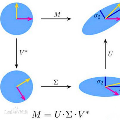Mapping images to deep feature space for comparisons has been wildly adopted in recent learning-based full-reference image quality assessment (FR-IQA) models. Analogous to the classical classification task, the ideal mapping space for quality regression should possess both inter-class separability and intra-class compactness. The inter-class separability that focuses on the discrimination of images with different quality levels has been highly emphasized in existing models. However, the intra-class compactness that maintains small objective quality variance of images with the same or indistinguishable quality escapes the research attention, potentially leading to the perception-biased measures. In this paper, we reveal that such bias is mainly caused by the unsuitable subspace that the features are projected and compared in. To account for this, we develop the Debiased Mapping based quality Measure (DMM), which relies on the orthonormal bases of deep learning features formed by singular value decomposition (SVD). The SVD in deep learning feature domain, which overwhelmingly separates the quality variations with singular values and projection bases, facilitates the quality inference with dedicatedly designed distance measure. Experiments on different IQA databases demonstrate the mapping method is able to mitigate the perception bias efficiently, and the superior performance on quality prediction verifies the effectiveness of our method. The implementation will be publicly available.
翻译:在最近基于学习的全面参考图像质量评估(FR-IQA)模型中,人们疯狂地采用了测深地貌空间的绘图图象,以便进行比较。与古典分类任务相比,质量回归的理想绘图空间应具有阶级间分离性和阶级内紧凑性。在现有模型中,高度强调了侧重于不同质量水平图像歧视的阶级间分离性;然而,在相同或无法区分质量的图像中保持小质量质量差异的阶级内部紧凑性,使研究注意力不及关注质量差异,有可能导致感知偏差的措施。在本文中,我们发现,这种偏差的主要原因是预测和比较这些特征的不合适的子空间。为此,我们开发了基于质量测量的偏差绘图(DMM),该测量以单值分解(SVD)形成的深层学习特征为主点。在深层学习特征领域,将质量差异与单值和投影基础大相区别,从而便利了质量的推导,用专门设计的远差差分测量,从而降低了质量。为此,在不同的IQ进行实验后,将可展示现有测算方法的质量。



